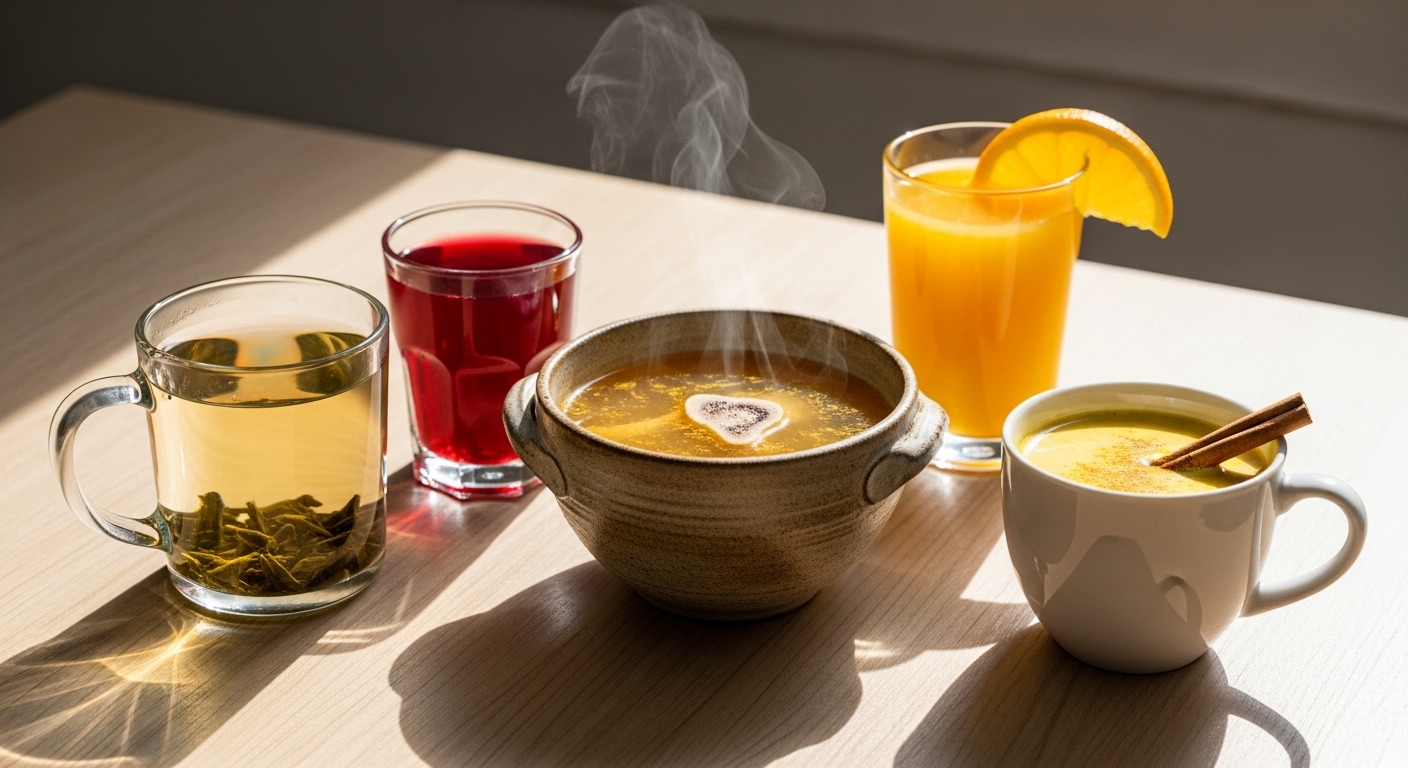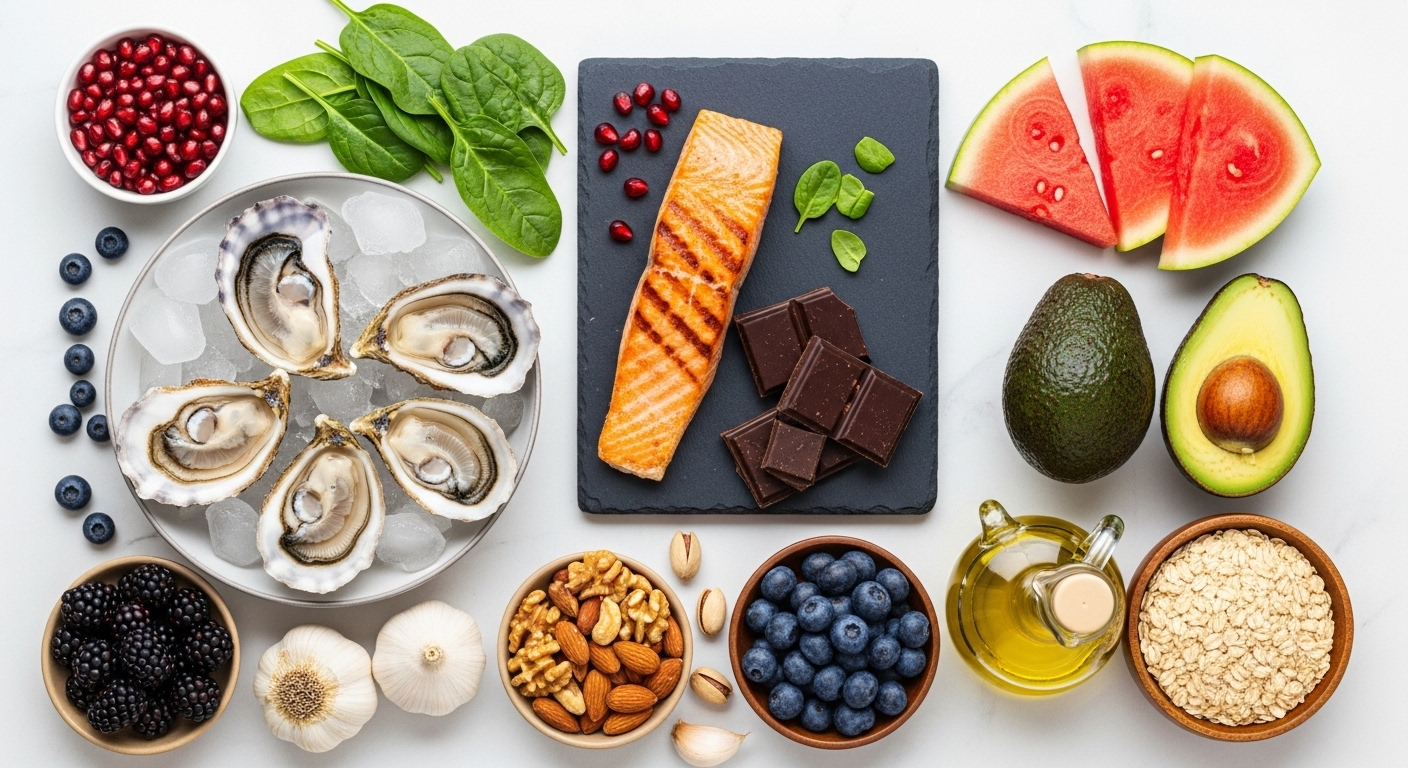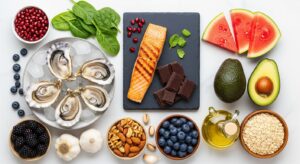5 Science-Backed Drinks That Actually Support Your Joint and Bone Health
If your knees ache when you climb stairs, or your joints feel stiff after sitting too long, you’re far from alone. Nearly 46 million Americans have been diagnosed with arthritis, and millions more are searching for practical ways to support their joint and bone health before problems start.
Here’s what most people don’t realize: the beverages you choose each day can genuinely impact how your joints feel and how strong your bones stay. I’m not talking about miracle cures or trendy wellness fads—I’m talking about drinks backed by peer-reviewed research published in respected medical journals.
After reviewing dozens of studies from institutions like Boston University Medical School, the National Institutes of Health, and research published in journals like Arthritis Research & Therapy and Osteoarthritis and Cartilage, I’ve identified five beverages that consistently show real benefits for joint and bone health. Better yet, they’re all easy to find and simple to incorporate into your daily routine.
Why Your Drink Choices Matter for Joints
Before we dive into specific beverages, let’s talk about why what you drink matters. Your cartilage—that crucial cushioning tissue between your bones—is approximately 80% water. When you’re dehydrated, that cartilage can’t absorb shock effectively, putting more stress on your joints.
But hydration is just the beginning. Certain compounds in beverages can reduce inflammation, provide building blocks for cartilage repair, and help your body absorb minerals that keep bones strong. The key is choosing drinks that deliver these benefits consistently.
1. Green Tea: The Anti-Inflammatory Powerhouse
Let’s start with what might be the most researched beverage for joint health: green tea.
The science behind it: Green tea contains a powerful polyphenol called epigallocatechin-3-gallate, or EGCG for short. This compound has been extensively studied by researchers, and the results are compelling. Studies published in Arthritis Research & Therapy have shown that EGCG can significantly slow the progression of osteoarthritis in animal models and provide genuine pain relief.
What’s happening at the cellular level is fascinating. Research demonstrates that EGCG globally suppresses inflammatory responses in chondrocytes—the cells responsible for maintaining healthy cartilage. It reduces the expression and activity of several inflammatory factors, including cyclooxygenase-2 (the same enzyme targeted by pain relievers like Celebrex), matrix metalloproteinases, and tumor necrosis factor-alpha. All of these contribute to cartilage breakdown when left unchecked.
A 2024 review in Frontiers in Medicine found that green tea catechins downregulate inflammatory mediators by suppressing key inflammation pathways, resulting in reduced chondrocyte death and cartilage erosion. Another study in Arthritis Research & Therapy showed that EGCG protected cartilage in a mouse model of post-traumatic osteoarthritis while also providing pain relief.
How to use it: Brew 2-3 cups daily for optimal benefits. Here’s an important detail most people miss: don’t use boiling water. After your kettle boils, let it cool for about 2 minutes (to around 160-180°F). Boiling water can destroy some of the beneficial compounds. Steep for 3-4 minutes.
If the taste is too bitter, add a slice of lemon—the vitamin C actually helps your body absorb the polyphenols better. Green tea contains about one-third the caffeine of coffee, but if you’re sensitive, have your last cup by early afternoon or choose decaf versions, which retain most beneficial compounds.
What the research shows: Multiple studies have demonstrated green tea’s protective effects on joints. Research published in the PMC National Library of Medicine confirms that EGCG inhibits the inflammatory signaling pathways that lead to cartilage degradation, making it a promising natural approach for supporting joint health.
2. Tart Cherry Juice: Nature’s Pain Reliever
Tart cherry juice has become increasingly popular among athletes and people with arthritis, and the research explains why.
The science behind it: Tart cherries, particularly the Montmorency variety used in most studies, are loaded with anthocyanins—the deep red pigments that give cherries their color. These anthocyanins have powerful anti-inflammatory properties. Think of them as nature’s version of ibuprofen, but without the stomach upset.
A well-designed study published in Osteoarthritis and Cartilage examined 58 people with knee osteoarthritis who drank tart cherry juice daily. The results showed that the juice provided symptom relief and significantly lowered high-sensitivity C-reactive protein (hsCRP), a key marker of inflammation in the body. Another study found that women with osteoarthritis who consumed tart cherry juice twice daily for 21 days experienced measurable decreases in inflammation markers.
The Arthritis Foundation reports that cherries contain more anthocyanins than most other fruits, including blueberries. These compounds work by suppressing inflammatory cytokines and reducing oxidative stress in joints. Research spanning multiple studies shows that tart cherries can help reduce pain and stiffness associated with arthritis.
How to use it: Look for 100% tart cherry juice—not “cherry juice cocktail,” which is mostly added sugar. Montmorency cherries are the variety most commonly used in research studies. Drink 8-12 ounces daily. Many people split this into two servings, one in the morning and one in the evening.
Real talk: Yes, it’s tart—really tart. You can dilute it with water or sparkling water if needed. Drinking it ice-cold helps, and honestly, you adjust to the taste after a few days. Some people mix it with a bit of apple juice, though that adds sugar.
What the research shows: A 2018 review published in Nutrients analyzing multiple studies concluded that cherry consumption has beneficial effects on arthritis, as well as sleep and cognitive function, due to its high polyphenol and vitamin C content. The evidence is strong enough that many physical therapists and sports medicine doctors now recommend tart cherry juice to their patients.
3. Bone Broth: The Collagen-Rich Traditional Remedy
Bone broth has been used in traditional medicine for centuries, and modern science is uncovering why it may actually work.
The science behind it: When you simmer bones for extended periods (12-24 hours), you extract collagen, glucosamine, chondroitin, and hyaluronic acid—all major components of healthy cartilage and joint fluid. The long cooking time breaks down the collagen from bones and connective tissue into gelatin, which contains important amino acids that support joint health.
Research published by the Arthritis Foundation found compelling results: a randomized controlled trial showed that 40 mg daily of undenatured type II collagen led to significantly less pain and stiffness and better function in people with osteoarthritis compared to those taking glucosamine plus chondroitin. Even more impressive, a comprehensive analysis of 41 animal and human studies, including 25 clinical trials, found that collagen benefited osteoarthritis and aided cartilage repair, regardless of dose, type, or brand.
A 2025 systematic review examining type I hydrolyzed collagen supplementation across multiple randomized controlled trials found promise for joint health, with effective doses ranging from 1.2 to 20 grams daily. The collagen in bone broth provides the building blocks—glycine, proline, and hydroxyproline—that your body uses to build and repair its own connective tissue.
However, transparency is important here. One study published in Sports Medicine found that homemade bone broth contains lower concentrations of these beneficial amino acids compared to commercial collagen supplements. The good news? Quality matters. When bone broth is made correctly and has that gel-like texture when cold, it does contain meaningful amounts of these compounds.
How to use it: You can make your own by simmering bones with a bit of apple cider vinegar for 12-24 hours (the acid helps extract collagen), or buy quality bone broth. Look for brands that list collagen content on the label—aim for at least 10 grams of protein per serving. Drink 1-2 cups daily, either on its own or as a base for soups.
Real talk: Good bone broth should gel when cold—that’s the collagen. If yours stays liquid in the fridge, it wasn’t simmered long enough. Store-bought options vary widely in quality. Pacific Foods and Kettle & Fire consistently test well for collagen content, though they’re pricier. MD Anderson Cancer Center notes that bone broth offers nutrients that may support bone health, including calcium, magnesium, and phosphorus, along with collagen’s amino acids that show anti-inflammatory benefits.
4. Calcium and Vitamin D Fortified Orange Juice: The Bone Builder
Before you skip this thinking orange juice has too much sugar, consider the bone health benefits backed by solid research.
The science behind it: Calcium and vitamin D work as a team—your bones need calcium to stay strong, but you can’t absorb calcium effectively without vitamin D. This partnership is so important that the National Institutes of Health identifies both as nutrients of concern in American diets because most people don’t get enough.
Research published in the American Journal of Clinical Nutrition by scientists at Boston University School of Medicine found something remarkable: fortification of orange juice with 1000 IU of vitamin D2 or D3 was equally as effective as vitamin D supplements in raising and maintaining healthy vitamin D levels in adults. In their 11-week study, 64% of participants started out vitamin D deficient, but the fortified orange juice successfully corrected this.
A large study analyzing NHANES data (the gold-standard nutritional survey of Americans) found that consumption of calcium and vitamin D-fortified orange juice was positively associated with femur bone mineral density in children and femur bone mineral content in both children and adults. Another study published in BMC Complementary Medicine showed that fortified orange juice increased markers of bone formation to a similar extent as milk.
The National Institutes of Health confirms that one 8-ounce serving of fortified orange juice provides about 30% of your daily calcium needs and 25% of your vitamin D needs—similar to an equal serving of milk. For people who are lactose intolerant or don’t drink milk, fortified orange juice offers an excellent alternative source of these critical bone-building nutrients.
How to use it: Choose 100% orange juice fortified with both calcium and vitamin D. Drink 8 ounces with breakfast—the small amount of fat in your meal helps your body absorb the vitamin D better. Be sure to shake the container well before pouring, as calcium can settle to the bottom.
Real talk: Yes, orange juice contains natural sugars (about 21 grams per cup). If that concerns you, dilute it half-and-half with water or sparkling water. You’ll still get the nutrients with less sugar impact. Or consider this: you’re getting actual bone-supporting nutrients with those natural sugars, unlike soda. Plus, the vitamin C in orange juice—over 100% of your daily needs in one glass—helps your body produce collagen for your joints and improves calcium absorption.
What the research shows: Studies consistently demonstrate that fortified orange juice is an effective way to improve vitamin D status. Research from Boston University found that the fat content of beverages doesn’t affect vitamin D absorption, which is why even fat-free orange juice can deliver these nutrients effectively.
5. Turmeric Golden Milk: The Anti-Inflammatory Evening Drink
This traditional Ayurvedic drink combines turmeric with black pepper and milk—a combination that science shows amplifies anti-inflammatory benefits dramatically.
The science behind it: Turmeric contains curcumin, one of the most studied anti-inflammatory compounds on the planet. The research is genuinely impressive. A comprehensive meta-analysis published in Frontiers in Immunology examined 29 randomized controlled trials involving 2,396 participants with various types of arthritis. The findings? Curcumin and turmeric extract administered in doses ranging from 120 mg to 1500 mg significantly improved symptoms across the board.
A Bayesian network meta-analysis—one of the most rigorous types of research reviews—analyzed 23 studies including 2,175 knee osteoarthritis patients. The results showed that curcumin significantly reduced pain scores and improved function compared to placebo. Even more impressive, a systematic review in the Journal of Medicinal Food found that curcumin extracts provided pain relief equivalent to or better than NSAIDs like ibuprofen for osteoarthritis symptoms.
Here’s how it works at the molecular level: curcumin blocks inflammatory cytokines and enzymes, including cyclooxygenase-2 (COX-2), the same target as the prescription pain reliever Celebrex. Research published in Arthritis Research & Therapy shows that curcumin modifies NF-κB signaling pathways—the master switch for inflammation in your body.
The challenge with curcumin has always been absorption. Your body doesn’t naturally absorb it well—only about 2-3% ends up in your bloodstream. This is where traditional wisdom meets modern science. Research published in Planta Medica found that combining curcumin with black pepper (which contains piperine) increases absorption by an astounding 2,000%. This is exactly why the traditional golden milk recipe includes black pepper.
A 2021 review of 15 randomized controlled trials found that curcumin relieved osteoarthritis pain and stiffness as well or better than NSAIDs—but without the potentially serious gastrointestinal side effects. Harvard Medical School researchers note that while more long-term studies are needed, the current evidence for curcumin in osteoarthritis is genuinely promising.
How to use it: Heat 1 cup of milk (dairy or unsweetened almond milk). Whisk in 1 teaspoon turmeric powder, 1/4 teaspoon black pepper (this is crucial—don’t skip it), 1/2 teaspoon cinnamon, and a small amount of honey for taste. Some people add a tiny bit of coconut oil or ghee since curcumin is fat-soluble, which aids absorption. Drink this in the evening—it’s naturally calming and can become part of a relaxing nighttime routine.
Real talk: Turmeric stains everything—your mug, your countertop, and temporarily your teeth. Use a dedicated mug and rinse immediately. The yellow fades from teeth quickly, or you can drink through a straw. Start with less turmeric if the flavor is too strong and gradually increase. I often make a big batch, keep it refrigerated, and warm up a cup as needed.
What the research shows: The Arthritis Foundation recommends 500 mg of high-quality curcumin twice daily for both osteoarthritis and rheumatoid arthritis. They note that curcumin seems to help restore a normal balance between inflammatory and protective T cells, which is particularly important for autoimmune forms of arthritis.
Making It Work in Your Daily Life
Here’s what I’ve learned from both the research and practical experience: you don’t need to drink all five of these every day. That’s overwhelming and unrealistic.
Instead, pick 2-3 that fit your lifestyle and rotate them. My typical approach: green tea in the morning, bone broth as a mid-morning snack or soup base, and golden milk three or four evenings a week. I keep tart cherry juice on hand for particularly active days or when I’m feeling extra stiff. I have fortified orange juice on days when I haven’t gotten much sun or other vitamin D sources.
Important reminders:
- These drinks support joint and bone health—they don’t replace medical treatment if you have diagnosed arthritis or other joint conditions
- If you’re on blood thinners, talk to your doctor before significantly increasing green tea or turmeric intake, as both can affect blood clotting
- Results take time. Give these beverages at least 4-6 weeks of consistent use before deciding whether they’re helping
- Continue drinking plain water too—these drinks supplement, rather than replace, proper hydration
- The National Institutes of Health notes that while these natural compounds show promise, they should be part of an overall approach that includes appropriate exercise, healthy weight management, and medical care when needed
The Bottom Line
Supporting your joints and bones doesn’t require expensive supplements or complicated routines. These five beverages—each backed by peer-reviewed research published in respected medical journals like Arthritis Research & Therapy, Osteoarthritis and Cartilage, American Journal of Clinical Nutrition, Frontiers in Immunology, and the Journal of Medicinal Food—offer real, measurable benefits when consumed regularly.
Start with one beverage that appeals to you. Make it part of your routine for a month. Pay attention to how you feel. Then maybe add another. Small, consistent actions compound over time, and your joints will thank you for it.
Your future self—whether that’s ten, twenty, or thirty years from now—is being built by what you do today. Making these simple, science-backed drinks part of your daily routine is one of those practical habits that actually works. No magic promises, just good science applied consistently to everyday life.














Post Comment